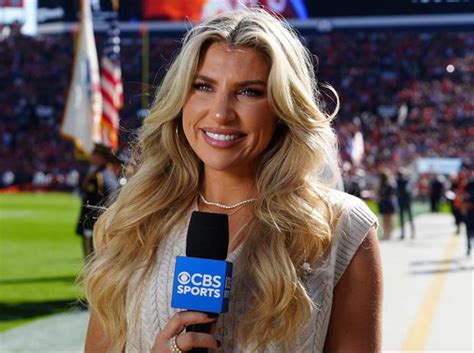
Melanie Collins, a sideline reporter for NFL on CBS, ignited social media Sunday with her choice of attire during a broadcast, drawing considerable attention and overwhelmingly positive reactions from viewers who lauded her “stunning” dress.
The eye-catching garment, worn during the NFL game coverage, quickly became a trending topic as fans took to platforms like X (formerly Twitter) to express their admiration for Collins’ sophisticated and stylish look. The positive response underscores the growing interest in sideline reporters’ on-air fashion choices, and their increasing influence on the broader sports-related cultural conversation. Collins, a seasoned sports broadcaster, has consistently garnered attention for her professional insights and on-screen presence, further solidifying her position as a prominent figure in sports media.
Social media users wasted no time in sharing their thoughts on Collins’ attire. One user wrote, “Melanie Collins is absolutely stunning in that dress!” while another added, “Her stylist deserves a raise. Melanie Collins looks incredible today.” The overwhelmingly positive feedback highlighted the impact that sideline reporters’ fashion choices can have, generating buzz and captivating viewers beyond just the game itself. This attention also sparks broader discussions about the role of women in sports broadcasting and the increasing emphasis on personal style within the industry.
Collins has built a strong reputation as a knowledgeable and engaging sports reporter. Before joining CBS, she worked for various networks, including ESPN, NBC, and the NFL Network. Her experience covers a wide range of sports, including football, basketball, and baseball, making her a versatile and well-respected figure in the field. Her move to CBS solidified her position among the top sideline reporters in the industry, and she consistently delivers insightful analysis and engaging interviews during game broadcasts.
“The dress was a total win,” commented fashion blogger Sarah Jenkins. “It was form-fitting without being overly revealing, and the color really popped against the green of the field. She looked professional and chic.” The comments underscore the importance of finding a balance between style and professionalism for women in sports broadcasting. Collins’ look seemingly struck that balance perfectly, appealing to a wide range of viewers.
The phenomenon of sideline reporters’ fashion choices attracting significant attention isn’t new. However, the increasing prevalence of social media amplifies these reactions, allowing for instant feedback and widespread discussion. In some instances, the attention can be negative, with commentators criticizing outfits as inappropriate or distracting. In Collins’ case, however, the response was overwhelmingly positive, highlighting the power of a well-chosen outfit to enhance a reporter’s on-screen presence and create a positive impression with viewers.
The attention surrounding Collins’ dress also reflects a broader trend in the sports industry, where athletes, coaches, and broadcasters are increasingly viewed as celebrities. Their personal lives, fashion choices, and social media presence are all subject to intense scrutiny, and they are often expected to cultivate a personal brand. Collins has successfully navigated this landscape, maintaining a professional demeanor while showcasing her personal style.
The positive reception to Collins’ dress suggests that viewers appreciate seeing sideline reporters who are both knowledgeable and stylish. By showcasing her personality and fashion sense, Collins is helping to break down traditional stereotypes about women in sports broadcasting and paving the way for a more diverse and inclusive industry.
The impact of Collins’ fashion statement extends beyond mere aesthetics. By generating buzz and capturing viewers’ attention, her choice of attire can also help to increase viewership and engagement with NFL broadcasts. In a competitive media landscape, where networks are constantly vying for audience attention, the ability to attract viewers through means beyond just the game itself is a valuable asset.
The dress incident also sparks a conversation about the double standards that women in sports broadcasting often face. Male commentators are rarely subject to the same level of scrutiny regarding their appearance, while female reporters are often judged more harshly for their fashion choices. While the response to Collins’ dress was largely positive, it underscores the need for greater awareness of these double standards and for a more equitable media landscape.
Looking ahead, it will be interesting to see how Collins continues to evolve her on-air style and how her fashion choices continue to resonate with viewers. Her success in capturing attention and generating positive feedback suggests that she has found a winning formula, and she is likely to remain a prominent figure in sports broadcasting for years to come. This incident also highlights the increasing importance of personal branding and social media engagement for sports reporters and the need for them to carefully manage their public image in an increasingly interconnected world. The positive attention Collins has received serves as a reminder that style and substance can coexist and that a well-chosen outfit can be a powerful tool for enhancing a reporter’s on-screen presence and connecting with viewers.
Collins’ attire choice resonates with a larger trend of personal style becoming more important in broadcasting. What was once a field focused almost entirely on journalistic skills has shifted to include expectations surrounding appearance and fashion. This shift presents both opportunities and challenges for broadcasters. On one hand, it allows them to express their individuality and connect with viewers on a more personal level. On the other hand, it can create pressure to conform to certain beauty standards and can distract from the actual reporting.
Collins’ ability to navigate this complex landscape with grace and professionalism has earned her the respect of her colleagues and the admiration of her fans. Her dress may have been the catalyst for this particular round of attention, but it is her skill as a reporter and her dedication to her craft that have truly cemented her place in the world of sports broadcasting. She has shown that it is possible to be both stylish and substantive, and that a strong personal brand can be a valuable asset in a competitive industry.
The reaction also serves as a reminder of the power of social media in shaping public perception. What might have once been a fleeting moment of appreciation or criticism can now become a viral sensation, with the potential to reach millions of people around the world. Broadcasters must be aware of this power and must be prepared to respond to both positive and negative feedback in a professional and constructive manner.
For women in sports broadcasting, the scrutiny of their appearance is often magnified, highlighting the need for networks to support their female talent and provide them with the resources they need to succeed. This support should include not only wardrobe and styling assistance but also mentorship and guidance on how to navigate the challenges of working in a male-dominated industry. By creating a more supportive and inclusive environment, networks can help to empower women in sports broadcasting and ensure that their voices are heard.
The attention surrounding Collins’ dress, while seemingly superficial, speaks to deeper issues related to gender, representation, and the evolving role of media personalities in the digital age. It is a reminder that appearance matters, but that substance matters even more. By balancing style with substance, Collins has proven that she is a force to be reckoned with in the world of sports broadcasting, and she is likely to continue to inspire and empower women in the industry for years to come.
Collins exemplifies the modern sports broadcaster, comfortable in front of the camera and adept at using social media to connect with fans. This dual role requires a unique skillset, and Collins has clearly mastered it. She understands that her appearance is part of her brand, but she also knows that her credibility as a reporter depends on her knowledge and expertise. This delicate balance is what sets her apart and makes her such a successful and respected figure in the industry.
Ultimately, the story of Melanie Collins and her “stunning” dress is a story about the intersection of sports, fashion, and social media. It is a story about the evolving role of women in broadcasting, and it is a story about the power of personal style. While the attention may have been focused on her attire, the underlying message is clear: Melanie Collins is a talented and accomplished reporter who is making a significant contribution to the world of sports media. And her choice of dress simply helped amplify that message.
The incident also brings forth the importance of sports journalism and media. Media personalities like Collins play a crucial role in shaping public opinion and driving conversations around sports events. In a world saturated with information, their ability to distill complex narratives and present them in an engaging and accessible way is invaluable. Their work extends beyond just reporting scores and statistics; they provide context, analysis, and human interest stories that connect fans to the games they love.
The emphasis on the style of female sports reporters, such as Melanie Collins, also subtly touches on the historical underrepresentation and stereotyping of women in sports media. Historically, the field has been dominated by men, and women have often faced significant barriers to entry and advancement. The focus on appearance, while sometimes superficial, can also be seen as a way for women to assert their presence and challenge traditional norms. By showcasing their individuality and style, they are demonstrating that women can be both knowledgeable and fashionable, and that they deserve to be taken seriously in the world of sports broadcasting.
The incident underscores the need for a more nuanced conversation about the role of women in sports media. While it is important to acknowledge the challenges and double standards that they face, it is equally important to celebrate their achievements and contributions. Women like Melanie Collins are not only breaking down barriers but also paving the way for future generations of female sports broadcasters. Their success is a testament to their talent, hard work, and dedication, and it is a reminder that the world of sports media is becoming more diverse and inclusive.
The attention surrounding Collins’ dress is a microcosm of the larger cultural conversation about beauty, fashion, and self-expression. In a society that is increasingly obsessed with image, it is important to remember that true beauty comes from within. While there is nothing wrong with taking pride in one’s appearance, it is equally important to cultivate inner qualities such as intelligence, kindness, and integrity. These are the qualities that truly define a person and that will ultimately determine their success and happiness.
The situation surrounding Melanie Collins’ dress also serves as a learning opportunity for young aspiring journalists, particularly young women, who are considering a career in sports broadcasting. It highlights the importance of developing a strong personal brand, mastering social media, and being prepared to navigate the challenges of working in a male-dominated industry. It also underscores the need to stay true to oneself, to maintain a professional demeanor, and to focus on the substance of one’s reporting. By following these principles, young aspiring journalists can position themselves for success and make a positive contribution to the world of sports media.
The discussion around Melanie Collins’ choice of attire brings up the question of authenticity in media. Authenticity is an essential quality that connects media personalities with their audience. In an environment of increased scrutiny and awareness, audiences can quickly distinguish between genuine expression and forced persona. Collins, who comes across as confident and comfortable, seems to resonate with viewers precisely because she appears genuine. The key takeaway is that it’s not just about what you wear, but how you carry yourself and how sincerely you connect with your audience.
In today’s media landscape, sports journalists often extend their reach beyond traditional television broadcasting. They actively use social media platforms to engage with fans, share insights, and build personal brands. This shift underscores the need for journalists to not only be skilled in reporting but also adept at content creation and audience engagement. Successful sports journalists, like Collins, understand that social media presence is not just an extension of their job; it’s an integral part of it.
Finally, the story of Melanie Collins and her dress underscores the cyclical nature of news and media. What starts as a fleeting moment or reaction can quickly escalate into a trending topic, sparking broader discussions and debates. For journalists, this means staying vigilant, being prepared to respond to unexpected events, and understanding the power of social media in shaping public opinion. In the age of instant communication, every moment is an opportunity to connect with audiences and contribute to the ongoing dialogue about sports, culture, and society.
FAQ Section:
-
What was the reaction to Melanie Collins’ dress?
The reaction was overwhelmingly positive, with fans on social media praising her “stunning” and stylish look. Many users complimented her stylist and expressed admiration for her on-screen appearance.
-
Where did the attention surrounding Melanie Collins’ dress primarily originate from?
The attention mainly originated from social media platforms, particularly X (formerly Twitter), where fans shared their positive reactions and comments about her dress.
-
What is Melanie Collins known for besides her appearance?
Melanie Collins is a seasoned sports broadcaster known for her insightful analysis, engaging interviews, and extensive experience covering a wide range of sports, including football, basketball, and baseball. She has worked for various networks, including ESPN, NBC, and the NFL Network, before joining CBS.
-
Why is there so much focus on the appearance of female sports reporters?
The focus on the appearance of female sports reporters often stems from historical double standards and the underrepresentation of women in the field. While there is nothing inherently wrong with appreciating style, the disproportionate emphasis on appearance can sometimes overshadow their professional achievements and contributions.
-
What impact do sideline reporters’ fashion choices have on the sports industry?
Sideline reporters’ fashion choices can generate buzz, attract viewers, and increase engagement with sports broadcasts. They also contribute to broader discussions about the role of women in sports broadcasting and the evolving expectations for media personalities in the digital age. Fashion choices help create a personal brand, connect with audiences, and challenge traditional norms.









